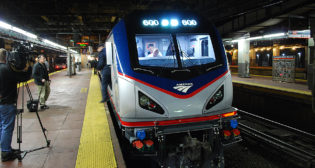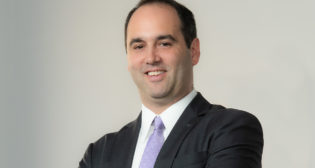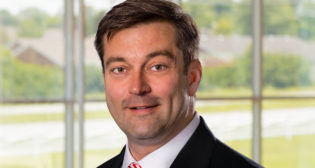
A refined grind
Written by William C. Vantuono, Editor-in-ChiefSustainable strategy Vossloh Rail Services is developing a High Performance Rail Milling Technology that will be operational by the end of 2014 and will be releasing a transit application of its HSG, High Speed Grinding, technology in 2013. According to Ron Martin, vice president and general manager, the HSG-city is specifically developed for the demands of transit systems focusing on preventative grinding, noise reduction, and corrugation removal. Powerful vacuums encapsulate the HSG-city’s grinding unit to capture all dust and sparks, which eliminates the requirement of cleaning the tunnels. The 24 passively driven grinding stones operate “virtually noiseless” at speeds between 15–38 mph and approximately 13 miles of rail can be ground nonstop. “Similar to use on high speed and mixed transport lines with the larger system, rail grinding in local transport with HSG technology is possible without train schedule disruption,” said Martin. “Due to changing environmental conditions, such as leaves or dirt getting on the rail, a low-friction coating can threaten operational safety. This may cause numerous problems to the rail and signal systems. Grinding cleans the rail, and thus, restores optimal wheel-rail contact, as well as the conduction of reverse current.” Vossloh Rail Services’ utilizes passively driven grinding stones on its High Speed Grinder, which adapt automatically to the rail’s profile. In the new HSG-2 generation, the grinding units can be individually adjusted to dedicated areas of the rail head to actively influence the rail profile. The company ensures a documented result by taking measurements of the longitudinal and the cross profile, as well the rail surface before and after grinding. Martin says that for future works, an on-board eddy current measuring device is planned to adapt the grinding strategy just in time to the demand of the rails. The company believes a combination of track inspection and rail maintenance is essential to developing a sustainable strategy for long-term optimization of the track conditions, which is why Vossloh Rail Services works closely with properties using its systems. Preventative and acoustical grinding Plasser American employs two main elements on its machines to accomplish grinding: Grinding units with oscillating movement and continuous work speeds. The company says the vertical force acting on the grinding units is hydraulically adjustable for precision results. The grinding stones, which can be water lubricated, adapt to the rail profile, resulting in rail irregularities being smoothed independently without creating grinding sparks. The grinding results of the rail surface are recorded for documentation and quality control purpose. While Plasser points out its oscillating grinding technique is well proven, the company is working to optimize it in order to provide additional economical advantages to its customers. When it comes to determining the most valuable grinding strategy, Plasser says preventative grinding of new rail and acoustical grinding are two important areas of application. Plasser points to various tests on different railway systems that show preventative grinding can delay surface flaws by more than 60 mgt and remove roughness from new rail, a result of the rail manufacturing process, which can slow down the appearance of surface ripples. The company says its grinding process, the previously mentioned combination of oscillating grinding units and continuous machine speed, creates an optimum rail surface, which contributes to noise reduction and can be referred to as acoustical grinding. “Many years of experience have shown that an oscillating grinding machine of the GWM series can produce a lower acoustical level, which is especially advantageous for tracks running through populated areas,” said Plasser. “The use of a GWM-550 between Sustern and Echt in Germany in June 2007 showed that by the use of oscillating grinding and reduction of surface roughness, the noise emission was lowered by 12 dBA. At Taegu Subway, Korea, an immediate noise reduction of 5 dBA was achieved using a GWM-250.” Studying the process Loram Maintenance of Way says an intense focus on the latest technology improves equipment speed, performance, and reliability, an understanding of the correlation between grind quality and the pre-inspection process, and continued research of rail deterioration helps advance the company’s grinding process. Darwin Isdahl, vice president, Asset Management Services, says grind quality begins with a well-defined pre-inspection process. Loram uses a rail inspection vehicle to measure rail profiles, which are then compared to a pre-determined optimal template and combined with an assessment of the rail surface condition to determine the depth of cut. “These two elements are essential to develop an accurate grind plan. The grind plan includes speeds, grind motor locations and number of passes required. This plan is then fed automatically into the grinder’s computerized control system. The horsepower of the grind motors is then adjusted as the machine speed varies to gain maximum production capabilities based on operating conditions, while maintaining consistent metal removal,” said Isdahl. “Our production grinders all feature an onboard profile measurement system to check compliance to the optimal profile, along with an encoder/DGPS location system that automatically selects the proper template for the track location. The grinding parameters and profile data is analyzed, stored, and available for future reference. Continuous improvement is made by analyzing the results of metal removal tests, evaluating results after grinding and soliciting feedback from the inspection personnel.” In addition to studying the grinding process, Loram works closely with the railroads in determining required parameters and how quality will be monitored. Loram recently entered into an agreement with a Class 1 railway to develop grind schedules, provide training, and work on continuous improvement activities to increase the benefits of grinding. Consistent maintenance regime Rail structure, says Harsco Rail, can be varied with its differing contours and impurities and in an application where accuracy is a must, technological assessments are instrumentally valuable when determining how to achieve a rail’s desired wheel/rail contact. Harsco works closely with railroads and emphasizes the use of various technological grinding applications during the inspection, execution, and evaluation phases of the process. Along with designing and manufacturing grinding equipment, Harsco employs rail consulting services that work directly with rail customers for their strategic and tactical issues about track construction, management, and maintenance. According to Harsco, this group collects valuable insight in dialogue with customers and delivers solutions beyond the use of equipment. The rail consulting department uses its SmartGrind system, a laser-based rail profile measurement system, to measure the rail profile before and after grinding and align the target profile to the measured profile. “The target profile can be specified by any user for the desired rail profile and can vary by degree of curvature and high/low rail elevation,” says Joseph Palese, Harsco Rail’s senior director of engineering and technology for its consulting services. “The result is the conformity of the currently measured rail profile to the desired profile, in the form of a Grinding Quality Index (GQI). “This conformity is also expressed as a difference curve or the amount of metal to be removed (by location across the rail head) in order to achieve conformity,” he says.



